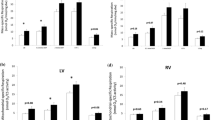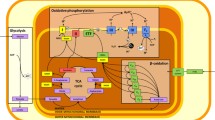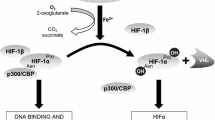Abstract
Hypoxia impairs the muscle fibre-type shift from fast-to-slow during post-natal development; however, this adaptation could be a consequence of the reduced voluntary physical activity associated with hypoxia exposure rather than the result of hypoxia per se. Moreover, muscle oxidative capacity could be reduced in hypoxia, particularly when hypoxia is combined with additional stress. Here, we used a model of muscle regeneration to mimic the fast-to-slow fibre-type conversion observed during post-natal development. We hypothesised that hypoxia would impair the recovery of the myosin heavy chain (MHC) profile and oxidative capacity during muscle regeneration. To test this hypothesis, the soleus muscle of female rats was injured by notexin and allowed to recover for 3, 7, 14 and 28 days under normoxia or hypobaric hypoxia (5,500 m altitude) conditions. Ambient hypoxia did not impair the recovery of the slow MHC profile during muscle regeneration. However, hypoxia moderately decreased the oxidative capacity (assessed from the activity of citrate synthase) of intact muscle and delayed its recovery in regenerated muscle. Hypoxia transiently increased in both regenerated and intact muscles the content of phosphorylated AMPK and Pgc-1α mRNA, two regulators involved in mitochondrial biogenesis, while it transiently increased in intact muscle the mRNA level of the mitophagic factor BNIP3. In conclusion, hypoxia does not act to impair the fast-to-slow MHC isoform transition during regeneration. Hypoxia alters the oxidative capacity of intact muscle and delays its recovery in regenerated muscle; however, this adaptation to hypoxia was independent of the studied regulators of mitochondrial turn-over.





Similar content being viewed by others
References
Rose MS, Houston CS, Fulco CS, Coates G, Sutton JR, Cymerman A (1988) Operation Everest II: nutrition and body composition. J Appl Physiol 65(6):2545–2551
Green HJ, Sutton JR, Cymerman A, Young PM, Houston CS (1989) Operation Everest II: adaptations in human skeletal muscle. J Appl Physiol 66(5):2454–2461
de Theije CC, Langen RC, Lamers WH, Schols AM, Kohler SE (2013) Distinct responses of protein turnover regulatory pathways in hypoxia- and semistarvation-induced muscle atrophy. Am J Physiol Lung Cell Mol Physiol 305(1):L82–L91
Favier FB, Costes F, Defour A, Bonnefoy R, Lefai E, Bauge S, Peinnequin A, Benoit H, Freyssenet D (2010) Downregulation of Akt/mammalian target of rapamycin pathway in skeletal muscle is associated with increased REDD1 expression in response to chronic hypoxia. Am J Physiol Regul Integr Comp Physiol 298(6):R1659–R1666
Bigard X, Sanchez H, Birot O, Serrurier B (2000) Myosin heavy chain composition of skeletal muscles in young rats growing under hypobaric hypoxia conditions. J Appl Physiol 88(2):479–486
Itoh M, Itoh K, Taguchi S, Hirofuji C, Takeuchi H, Ishihara A (1992) Effect of hypobaric hypoxia on fiber type composition of the soleus muscle in the developing rat. Aviat Space Environ Med 63(7):583–587
Hirofuji C, Ishihara A, Itoh K, Itoh M, Taguchi S, Takeuchi-Hayashi H (1992) Fibre type composition of the soleus muscle in hypoxia-acclimatised rats. J Anat 181(Pt 2):327–333
Faucher M, Guillot C, Marqueste T, Kipson N, Mayet-Sornay MH, Desplanches D, Jammes Y, Badier M (2005) Matched adaptations of electrophysiological, physiological, and histological properties of skeletal muscles in response to chronic hypoxia. Pflugers Arch 450(1):45–52
Ishihara A, Itoh K, Itoh M, Hirofuji C (2000) Effect of hypobaric hypoxia on rat soleus muscle fibers and their innervating motoneurons: a review. Jpn J Physiol 50(6):561–568
Chaillou T, Koulmann N, Meunier A, Malgoyre A, Serrurier B, Beaudry M, Bigard X (2013) Effect of hypoxia exposure on the phenotypic adaptation in remodelling skeletal muscle submitted to functional overload. Acta Physiol (Oxf) 209(4):272–282
Gamboa JL, Andrade FH (2010) Mitochondrial content and distribution changes specific to mouse diaphragm after chronic normobaric hypoxia. Am J Physiol Regul Integr Comp Physiol 298(3):R575–R583
van Ekeren GJ, Sengers RC, Stadhouders AM (1992) Changes in volume densities and distribution of mitochondria in rat skeletal muscle after chronic hypoxia. Int J Exp Pathol 73(1):51–60
Howald H, Hoppeler H (2003) Performing at extreme altitude: muscle cellular and subcellular adaptations. Eur J Appl Physiol 90(3–4):360–364
Hoppeler H, Vogt M, Weibel ER, Fluck M (2003) Response of skeletal muscle mitochondria to hypoxia. Exp Physiol 88(1):109–119
Hoppeler H, Kleinert E, Schlegel C, Claassen H, Howald H, Kayar SR, Cerretelli P (1990) Morphological adaptations of human skeletal muscle to chronic hypoxia. Int J Sports Med 11(Suppl 1):S3–S9
Howald H, Pette D, Simoneau JA, Uber A, Hoppeler H, Cerretelli P (1990) Effect of chronic hypoxia on muscle enzyme activities. Int J Sports Med 11(Suppl 1):S10–S14
Charge SB, Rudnicki MA (2004) Cellular and molecular regulation of muscle regeneration. Physiol Rev 84(1):209–238
Fink E, Fortin D, Serrurier B, Ventura-Clapier R, Bigard AX (2003) Recovery of contractile and metabolic phenotypes in regenerating slow muscle after notexin-induced or crush injury. J Muscle Res Cell Motil 24(7):421–429
Crassous B, Richard-Bulteau H, Deldicque L, Serrurier B, Pasdeloup M, Francaux M, Bigard X, Koulmann N (2009) Lack of effects of creatine on the regeneration of soleus muscle after injury in rats. Med Sci Sports Exerc 41(9):1761–1769
Whalen RG, Harris JB, Butler-Browne GS, Sesodia S (1990) Expression of myosin isoforms during notexin-induced regeneration of rat soleus muscles. Dev Biol 141(1):24–40
Harris JB (2003) Myotoxic phospholipases A2 and the regeneration of skeletal muscles. Toxicon 42(8):933–945
Chin ER, Olson EN, Richardson JA, Yang Q, Humphries C, Shelton JM, Wu H, Zhu W, Bassel-Duby R, Williams RS (1998) A calcineurin-dependent transcriptional pathway controls skeletal muscle fiber type. Genes Dev 12(16):2499–2509
Banzet S, Koulmann N, Simler N, Birot O, Sanchez H, Chapot R, Peinnequin A, Bigard X (2005) Fibre-type specificity of interleukin-6 gene transcription during muscle contraction in rat: association with calcineurin activity. J Physiol 566(Pt 3):839–847
Yan Z, Okutsu M, Akhtar YN, Lira VA (2011) Regulation of exercise-induced fiber type transformation, mitochondrial biogenesis, and angiogenesis in skeletal muscle. J Appl Physiol 110(1):264–274
Narkar VA, Downes M, Yu RT, Embler E, Wang YX, Banayo E, Mihaylova MM, Nelson MC, Zou Y, Juguilon H, Kang H, Shaw RJ, Evans RM (2008) AMPK and PPARdelta agonists are exercise mimetics. Cell 134(3):405–415
Band M, Joel A, Hernandez A, Avivi A (2009) Hypoxia-induced BNIP3 expression and mitophagy: in vivo comparison of the rat and the hypoxia-tolerant mole rat, Spalax ehrenbergi. FASEB J 23(7):2327–2335
Chaillou T, Koulmann N, Meunier A, Pugniere P, McCarthy JJ, Beaudry M, Bigard X (2013) Ambient hypoxia enhances the loss of muscle mass after extensive injury. Pflugers Arch [Epub ahead of print]
Chaillou T, Koulmann N, Simler N, Meunier A, Serrurier B, Chapot R, Peinnequin A, Beaudry M, Bigard X (2012) Hypoxia transiently affects skeletal muscle hypertrophy in a functional overload model. Am J Physiol Regul Integr Comp Physiol 302(5):R643–R654
Bigard AX, Boehm E, Veksler V, Mateo P, Anflous K, Ventura-Clapier R (1998) Muscle unloading induces slow to fast transitions in myofibrillar but not mitochondrial properties. Relevance to skeletal muscle abnormalities in heart failure. J Mol Cell Cardiol 30(11):2391–2401
Yang J, Rothermel B, Vega RB, Frey N, McKinsey TA, Olson EN, Bassel-Duby R, Williams RS (2000) Independent signals control expression of the calcineurin inhibitory proteins MCIP1 and MCIP2 in striated muscles. Circ Res 87(12):E61–E68
Liu L, Cash TP, Jones RG, Keith B, Thompson CB, Simon MC (2006) Hypoxia-induced energy stress regulates mRNA translation and cell growth. Mol Cell 21(4):521–531
Bonnet S, Rochefort G, Sutendra G, Archer SL, Haromy A, Webster L, Hashimoto K, Bonnet SN, Michelakis ED (2007) The nuclear factor of activated T cells in pulmonary arterial hypertension can be therapeutically targeted. Proc Natl Acad Sci USA 104(27):11418–11423
Sutendra G, Bonnet S, Rochefort G, Haromy A, Folmes KD, Lopaschuk GD, Dyck JR, Michelakis ED (2010) Fatty acid oxidation and malonyl-CoA decarboxylase in the vascular remodeling of pulmonary hypertension. Sci Transl Med 2(44):44ra58
Duguez S, Feasson L, Denis C, Freyssenet D (2002) Mitochondrial biogenesis during skeletal muscle regeneration. Am J Physiol Endocrinol Metab 282(4):E802–E809
Jager S, Handschin C, St-Pierre J, Spiegelman BM (2007) AMP-activated protein kinase (AMPK) action in skeletal muscle via direct phosphorylation of PGC-1alpha. Proc Natl Acad Sci USA 104(29):12017–12022
Guerfali I, Manissolle C, Durieux AC, Bonnefoy R, Bartegi A, Freyssenet D (2007) Calcineurin A and CaMKIV transactivate PGC-1alpha promoter, but differentially regulate cytochrome c promoter in rat skeletal muscle. Pflugers Arch 454(2):297–305
Jiang LQ, Garcia-Roves PM, de Castro Barbosa T, Zierath JR (2010) Constitutively active calcineurin in skeletal muscle increases endurance performance and mitochondrial respiratory capacity. Am J Physiol Endocrinol Metab 298(1):E8–E16
Kusuhara K, Madsen K, Jensen L, Hellsten Y, Pilegaard H (2007) Calcium signalling in the regulation of PGC-1alpha, PDK4 and HKII mRNA expression. Biol Chem 388(5):481–488
Gamboa JL, Andrade FH (2012) Muscle endurance and mitochondrial function after chronic normobaric hypoxia: contrast of respiratory and limb muscles. Pflugers Arch 463(2):327–338. doi:10.1007/s00424-011-1057-8
Li Y, Wang Y, Kim E, Beemiller P, Wang CY, Swanson J, You M, Guan KL (2007) Bnip3 mediates the hypoxia-induced inhibition on mammalian target of rapamycin by interacting with Rheb. J Biol Chem 282(49):35803–35813
Acknowledgments
We thank Dr. Nadine Simler (Institut de Recherche Biomédicale des Armées) for helpful technical assistance, Dr. André Peinnequin and Dr. Pascal Pugnière (Institut de Recherche Biomédicale des Armées) for useful discussions about RT-qPCR analysis and Dr. John J. McCarthy (Department of Physiology, University of Kentucky, USA) for careful reading of the manuscript. This work was supported by a predoctoral fellowship from the Ministère de I’Enseignement Supérieur et de la Recherche to TC and by the Association Française contre les Myopathies (Grant number 13955 to MB and XB).
Conflict of interest
No conflicts of interest, financial or otherwise, are declared by the author.
Author information
Authors and Affiliations
Corresponding author
Rights and permissions
About this article
Cite this article
Chaillou, T., Koulmann, N., Meunier, A. et al. Effect of hypoxia exposure on the recovery of skeletal muscle phenotype during regeneration. Mol Cell Biochem 390, 31–40 (2014). https://doi.org/10.1007/s11010-013-1952-8
Received:
Accepted:
Published:
Issue Date:
DOI: https://doi.org/10.1007/s11010-013-1952-8




